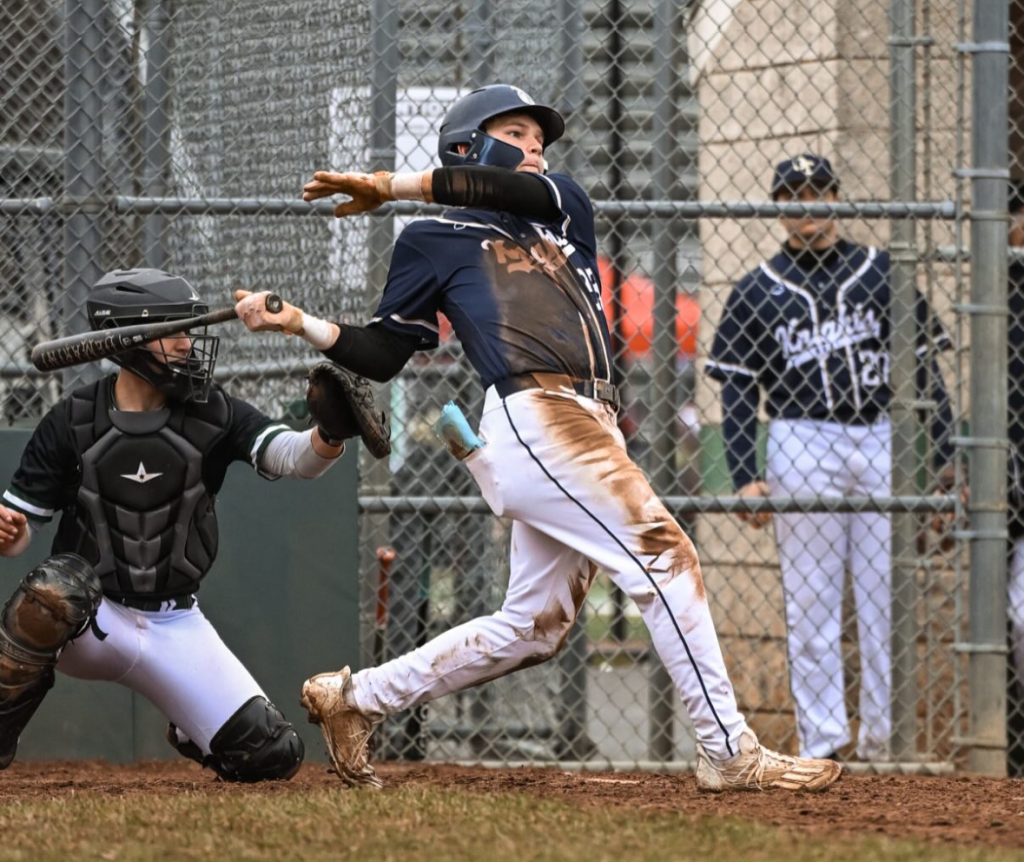
Outfielder and utility player AJ Aiello (Class 2026 – Old Tappan HS, NJ) joined us last fall for the RPP off-season hitting / strength program. In general, he was looking to increase his exit velo, and improve his adjustability and consistency at the plate. By the end of February this year, his top-end exit velo had improved from the mid-80s to 93 mph. This spring, he is off to a great start, currently batting .324 and slugging .559, versus .125 in both metrics the prior year.
How did he do it?
High school age position players that are eligible to enroll in our more advanced strength training programs begin the process with a comprehensive physical and mechanical evaluation. This includes the following:
-
- Physical Assessment – Covers a number of important topics, including (a) lower and upper half mobility (b) lower and upper half strength (c) lower and upper half power (d) speed – 30-yard dash, (e) lower and upper half elasticity – (f) decel metrics, (g) body fat % and lean mass ratios and finally a force-velocity evaluation profile.
- Mechanical Assessment – Represents a complete analysis and reporting of the athlete’s hitting mechanics, including, (a) video analysis – linear and rotational phases, (b) Blast Motion metrics, and (c) K-vest Postural analysis
By the conclusion of the evaluation, we have an excellent idea of strengths and weaknesses that need to be addressed to optimize performance. There is NO better blueprint!
1. Physical Assessment
Body Composition
Below is a summary of AJ’s height, weight, and body fat % in the beginning of the program.
-
- Height – 73”
- Weight – 209 lbs.
- Ratio – 2.86x (desired rage of 2.5 – 3.0)
- Body Fat – 19%
AJ entered our program already within the metrics of what we generally look for height/weight ratio-wise. However, at a body fat percentage of 18% we knew that if we could slim him down a bit body fat-wise, he may be able to control his mass better when moving towards the plate and giving him a more athletic swing overall.
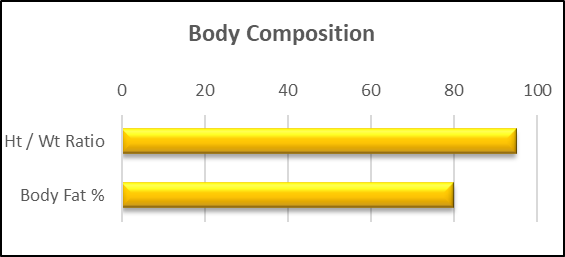
Upper and Lower Half Mobility
The movement screening portion of the assessment is essential in identifying mobility and / or stability issues that may hinder the athlete’s ability to get into optimal positions throughout the delivery. In most cases, the issues that are presented in this portion of the assessment will be visible when we are evaluating the athlete’s mechanics in the video analysis portion of the assessment.
While AJ’s mobility presented as very good initially but addressing the slight tightness in his front hip and right t-spine rotation we felt could help not only better transfer of force up the chain but more power to his pull side.

Upper and Lower Body Strength
After completion of the movement screen, we move on to our strength and power testing to help give us more information about the type of athlete we were dealing with. Higher gains in these two categories help to create not only a higher ceiling, but an overall more athletic body.
The following is the summary of AJ’s 1RM metrics in the weight room at the time of his assessment.
-
- Trap Bar Deadlift – 371 lbs.
- Single Leg Squat – 86 lbs.
- Bench Press – 174 lbs.
Here is where we could see much of our work getting done. Getting AJ to produce more force in the weight room will more than likely produce more force into the ball.
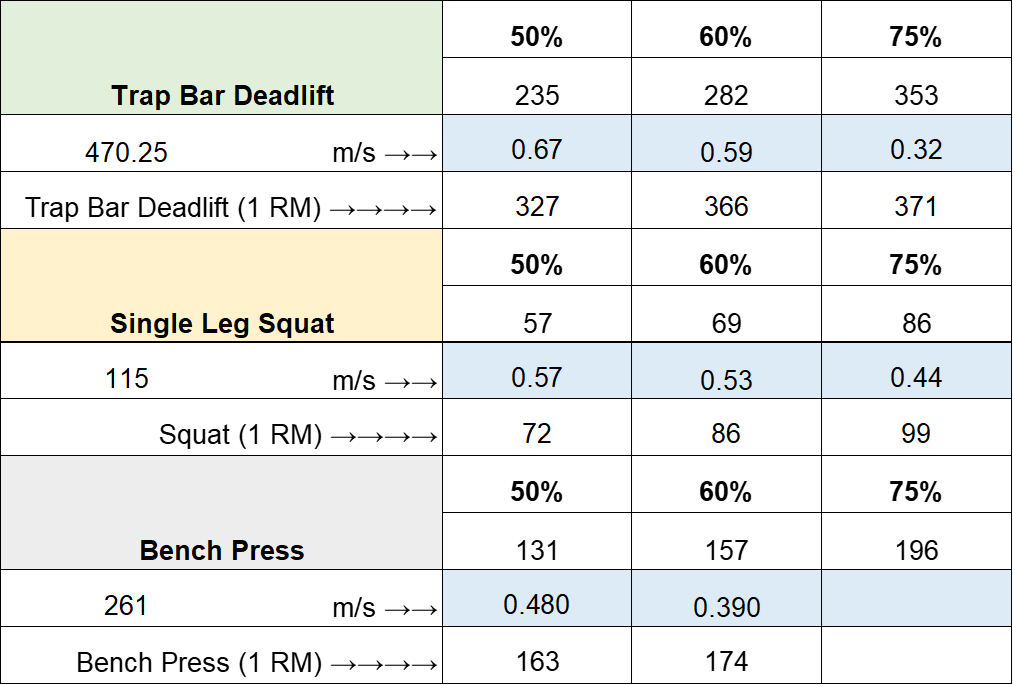
Lower and Upper Half Power
Power is all about how quickly we can produce Force. In baseball, you need to be both strong and powerful. Power = Force X Velocity
Lower Half – With respect to power, the first test we complete is a Counter Movement Jump (CMJ). This jump is performed to assess the athlete’s ability to utilize their Stretch Shortening Cycle and relates to the velocity portion of the power equation and ultimately gives us the athletes Force-Velocity profile.
The second test, Squat Jump, is performed to evaluate the athlete’s ability to use muscular force and relates to the force side of the power equation and Force-Velocity Curve.
Looking at AJ’s power numbers, we can see that more than likely his power is leaking from his upper half rather than his lower half (see below). Remember, it’s not always ONLY about the lower half!
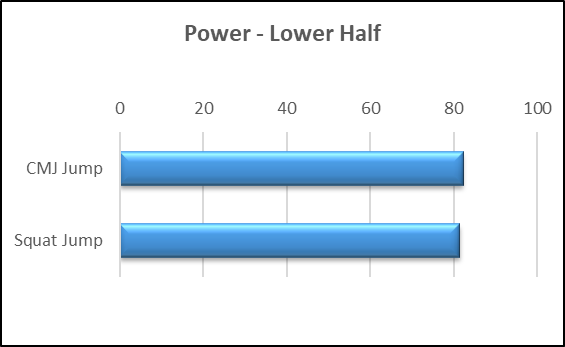
Upper Half – We assess upper half rotational power on a Proteus Motion machine, utilizing two different tests:
-
- Trunk Rotation – Similar to the squat jump this involves no “pre-stretch”
- Plyo Trunk Rotation – Same movement with a “pre-stretch”
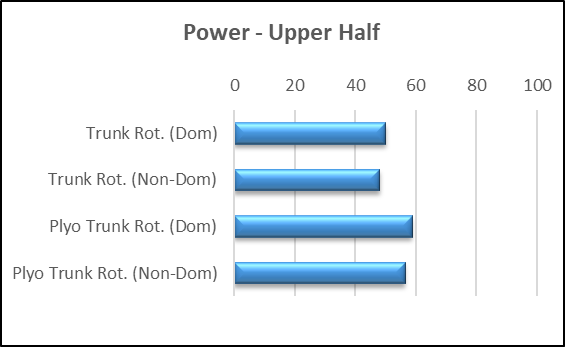
Decel
This test looks at the ability of the athlete’s lead leg to hit the brakes immediately at foot plant and in turn transfer force back up the kinetic chain to use during the throw, or in the case of the test, how quickly they can land on one leg and turn that force the other way with a jump. Jump height and contact time give us what is known as a “Reactive Strength Index” (RSI).
Generally, when we see athletes that present with a good amount of lower body strength, like AJ, but lower than optimal deceleration during testing, we need to look at the foot / ankle complex. Weakness in the ankle and calf will force the athlete to place an internal governor on the entire kinetic chain while at the same time, reducing an athlete’s ability to create maximum power output quickly, especially on one leg.

2. Hitting Mechanics
The hitting mechanics evaluation involves three different components:
-
- Video Analysis
- Blast Motion Swing Metrics
- K-vest Postural Analysis
Video Analysis – AJ’s hitting mechanics have improved dramatically during this time period. The following is a summary of AJ’s video analysis before and after, which demonstrates how he has cleaned up much of his hitting mechanics.
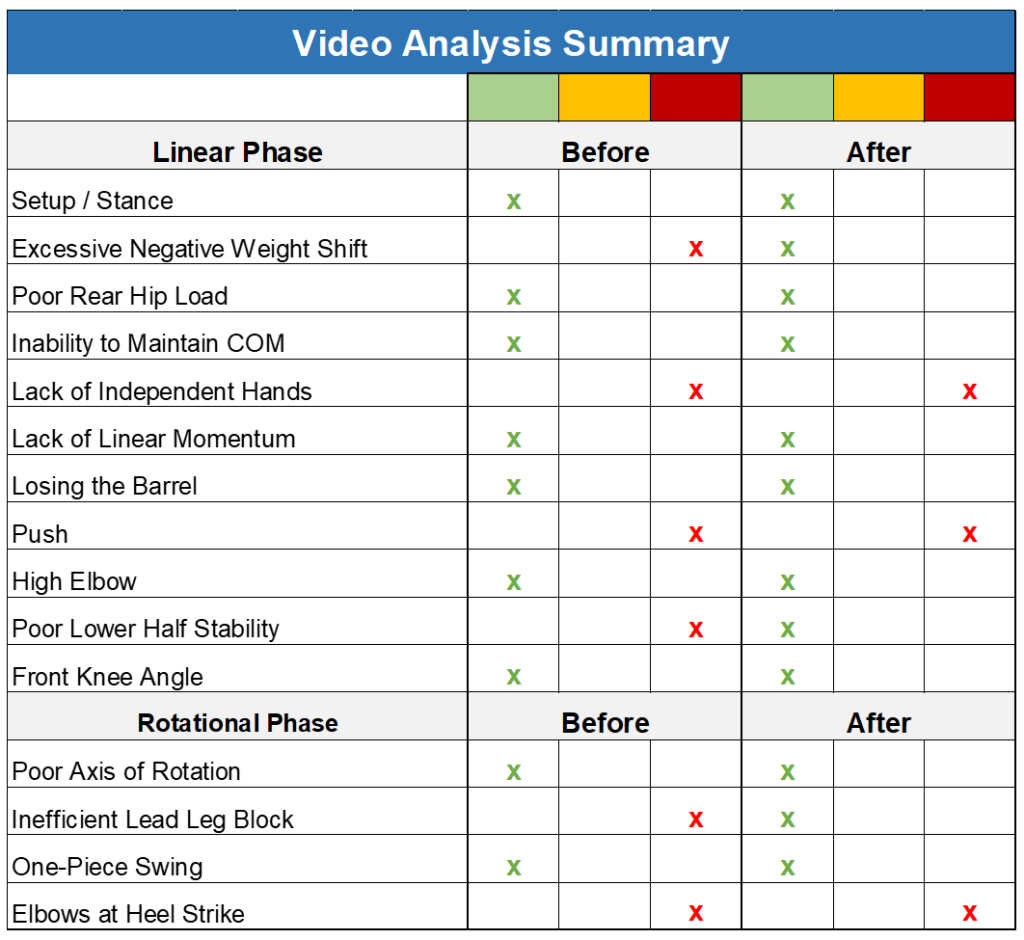
Blast Motion Swing Metrics – The following is a highlight of AJ’s improved Blast Motion metrics which should have a big impact on his performance at the plate:
-
- Bat Speed – 61 mph >> 68 mph
- Attack Angle – 5 degrees >> 10 mph
- Power – 3.2 watts > 3.9 watts
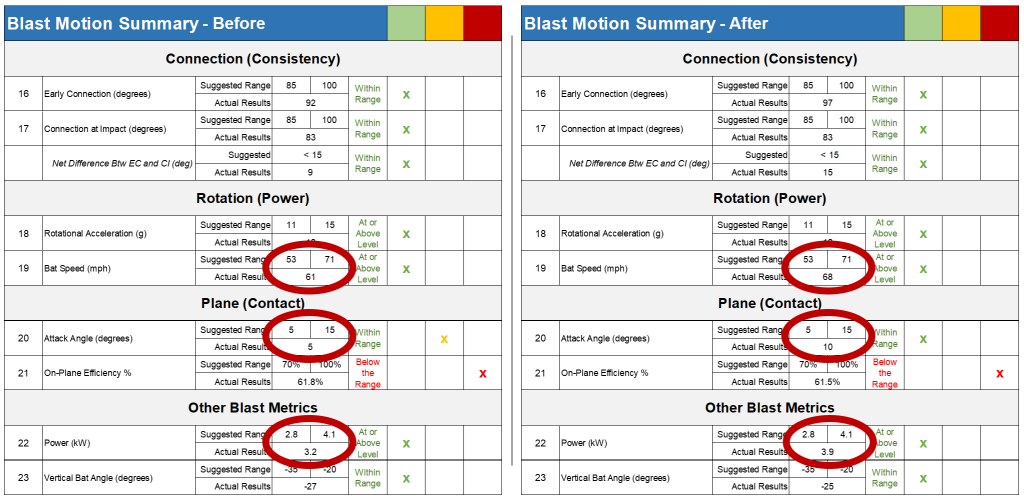
Three of the above metrics stood out in his initial eval as areas that we needed to address (colored in red):
-
- Bat Speed – When it comes to hitting, bat speed is king, and AJ has done a nice job improving his bat speed.
- Attack Angle – Perhaps one of the most significant improvements in his swing metrics came from increasing his average Attack Angle from 5 to 10 degrees. Although 5 is generally within the range of preferred AAs, given the standard deviation of this metric, an AA of 10 is definitely more in the sweet spot.
- Power – AJ’s Blast Power metrics have improved from 3.2 to 3.9, a 22% improvement. This increase will reflect itself nicely on his batted ball results.
K-vest Postural Analysis – K-vest is a biomechanics tool that allows us to evaluate a player’s kinematic sequence and postural metrics during the swing.
Sequencing – Kinematics sequence is the process by which the athlete creates angular velocity up the kinetic chain, beginning with the pelvis (1), to the torso (2), to the shoulder (3) and finally to the hand (4).
The following is a summary AJ’s “before and after” sequencing metrics. AJ’s pelvis (1) all the way through to the hands (4) is now sequencing efficiently. You can also see that his angular velocities from segment-to segment are up approximately 40% or more across the sequence. These improvements in angular velocity should help AJ become more adjustable at the plate when facing various pitch locations and speeds.

Posture – Postural metrics are the measurements associated with specific body parts at 3 different points along the swing, at heel strike, at first move and at contact. AJ’s hitting mechanics had very minor postural disconnects as outlined below. The two that we focused on most with corrective drill work inside the nets are listed below:
-
- Pelvis Bend at First Move – Often, low numbers can signify an athlete is losing their hinge early. This can create a loss of posture, resulting in sub-optimal reaction to ground forces as well as losing the arc in the swing path.
- Torso Bend at Contact – A negative number here is preferred. Positive numbers signify that we may be “through” the front leg instead of against it and ultimately leaking power through the chain.
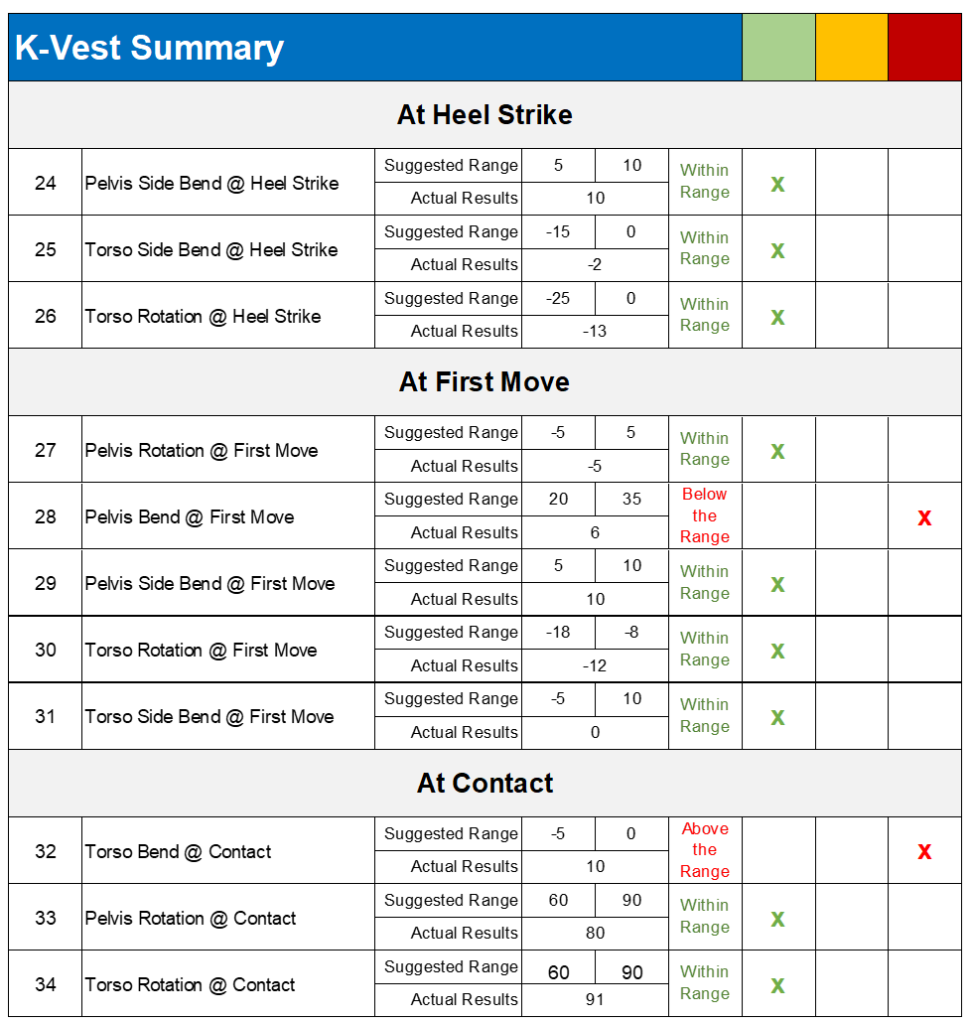
Summary
AJ made big strides in his development during the past off-season. As mentioned earlier, by March, his exit velo had increased from mid-80s into the low 90s.

In addition, his improved swing metrics will help him make better contact at the plate, and on a more consistent basis:
-
- Bat Speed – 61 mph >> 68 mph
- Attack Angle – 5 degrees >> 10 mph
- Power – 3.2 watts > 3.9 watts
This is all the result of much hard work AJ put in this off-season, inside and outside the nets. This spring his BA and Power at the plate have increased significantly from the prior year, currently batting .324 and slugging .559 with 2 HRs., all substantial improvements from the prior year.
Keep up the hard work AJ!
By Andrew Pezzutto and Nunzio Signore
If you’re interested in receiving our blogs, please enter your email address below!
You live too far to train with us in-house at RPP? You can now train with us on a REMOTE basis.


